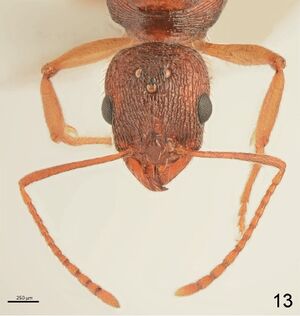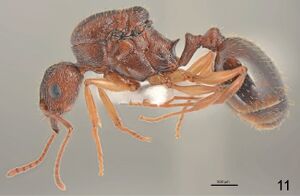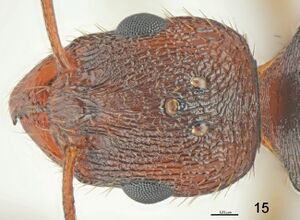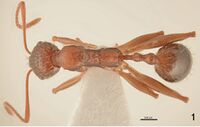Aphaenogaster rugosoferruginea
| Aphaenogaster rugosoferruginea | |
|---|---|

| |
| Scientific classification | |
| Kingdom: | Animalia |
| Phylum: | Arthropoda |
| Class: | Insecta |
| Order: | Hymenoptera |
| Family: | Formicidae |
| Subfamily: | Myrmicinae |
| Tribe: | Attini |
| Genus: | Aphaenogaster |
| Species group: | splendida |
| Species: | A. rugosoferruginea |
| Binomial name | |
| Aphaenogaster rugosoferruginea Forel, 1889 | |
A forest species with nests that can be found under large stones.
Aphaenogaster rugosoferruginea is a diurnal species, most often found in shaded places inside deciduous forests or limestone gorges. Foraging workers were observed mostly on stones and rocks inside forests or walls of rocks in gorges, during hot days single workers were often observed under stones. It is a monogynous species, nesting under large stones. The number of workers observed in the nest did not exceed 40 individuals (Salata et al., 2021).
Identification
Borowiec and Salata (2013) – First described as a subspecies of Aphaenogaster splendida, A. rugosoferruginea has workers that are well distinguished from A. splendida in sculpture, coloration and gyne morphology.
At first glance, Aphaenogaster rugosoferruginea differs from A. splendida in darker coloration with head and thorax rusty yellow to yellowish-brown while A. splendida is pure yellow coloured. In general body shape A. rugosoferruginea is stouter than A. splendida with promesonotum only twice as long as wide vs. 2.3 times, pronotum is more convex and eyes larger, head slightly larger and stouter behind eyes, less converging posterad than in A. splendida. Aphaenogaster splendida has distinctly longer antennal scapes, approximately 1.8 times as wide as width of head vs. 1.55 in A. rugosoferruginea and slimmer legs. Although most measurements overlap in both species A. rugosoferruginea appears to be slightly larger, stouter, with relativery shorter and stouter legs, broader mesosoma and stouter head. The best distinguishing characters are in body sculpture. In A. rugosoferruginea the whole dorsal surface of head is strongly sculptured, with longitudinal and reticulate rugae and distinct microreticulation between primary sculpture, the whole vertex is reticulate and thus the surface of head appears dull. In A. splendida the head is mostly microreticulate with distinct rugae only below eyes and sometimes a few rugae along the inner margin of eyes, on vertex microreticulation often diffuse thus top of head often appears more or less shiny. The pronotum of A. rugosoferruginea is distinctly sculptured, appears dull while in A. splendida pronotum is at most partly microreticulate with top more or less shiny. The gynes differ markedly in coloration. A. rugosoferruginea is darker coloured, rusty-yellow to rusty-brown while in A. splendida whole body is yellow. The head in A. rugosoferruginea is more distinctly sculptured with oblique and transverse rugae on the vertex, 15), while in A. splendida the vertex is only microreticulate; also the mesosomal plate in A. rugosoferruginea is more distinctly rugose than in A. splendida. They distinctly differ in shape of propodeal spine, shorter and spiniform in A. rugusoferruginea and longer and finger-shaped in A. splendida.
Salata et al. (2021) - Aphaenogaster rugosoferruginea morphologically resembles Aphaenogaster festae but its dark, yellowish-brown to brown color of body reminds also Aphaenogaster aktaci and Aphaenogaster ovaticeps. Aphaenogaster rugosoferruginea is a slightly paler than A. aktaci and A. ovaticeps, with most specimens rather yellowish-brown colored, while in two other taxa predominate darker brown colored specimens. Aphaenogaster aktaci differs additionally in larger body size (WL 1.54–2.01 vs. 1.45–1.65), longitudinal not transverse rugosities on propodeal dorsum, larger and thicker propodeal spines and first gastral tergite lacking pale basal spot. Aphaenogaster ovaticeps distinctly differs with regularly oval and less rugose head, and very long and thin antennae and legs. Aphaenogaster festae and its relatives (Aphaenogaster syriaca, Aphaenogaster schmitzi and Aphaenogaster transcaucasica) look very similar to A. rugosoferruginea but differ in distinctly paler body, yellow to rusty-yellow and less distinctly microreticulate base of first gastral tergite. Aphaenogaster rugosoferruginea is also separated geographically from remaining members of the A. festae complex and is endemic to Crete.
Distribution
Endemic to Crete; old records from other parts of Greece are most likely based on misidentifications of other species of the A. splendida group (Salata et al., 2021).
Recent material suggests that Aphaenogaster rugosoferruginea is restricted only to Crete and records from Aegean islands and Cyprus based probably on misidentification with Aphaenogaster festae or some undescribed taxa of Aphaenogaster splendida group (Borowiec, 2014).
Latitudinal Distribution Pattern
Latitudinal Range: 37.583333° to 35.05°.
| North Temperate |
North Subtropical |
Tropical | South Subtropical |
South Temperate |
- Source: AntMaps
Distribution based on Regional Taxon Lists
Palaearctic Region: Greece (type locality).
Distribution based on AntMaps
Distribution based on AntWeb specimens
Check data from AntWeb
Countries Occupied
| Number of countries occupied by this species based on AntWiki Regional Taxon Lists. In general, fewer countries occupied indicates a narrower range, while more countries indicates a more widespread species. |

|
Estimated Abundance
| Relative abundance based on number of AntMaps records per species (this species within the purple bar). Fewer records (to the left) indicates a less abundant/encountered species while more records (to the right) indicates more abundant/encountered species. |

|
Biology
Borowiec and Salata (2013) - Forest species, prefers leaf forest, especially oak forests, most nests were found in soil under large stones, occasionally nests were observed inside the big porous limestone boulders but never within caves or rock crevices or inside the stone culverts under roads which is characteristic for some other species of A. splendida group, e.g., A. ovaticeps, but the preferences are similar to that observed for A. splendida which prefers soil nests under stones but the only nest we found was in pine forest.
Life History Traits
- Queen number: monogynous (Salata et al., 2021)
- Maximum colony size: 40 (Salata et al., 2021)
- Nest site: under objects (Salata et al., 2021)
Castes
Queen
    
| |
| . | |
Nomenclature
The following information is derived from Barry Bolton's Online Catalogue of the Ants of the World.
- rugosoferruginea. Aphaenogaster splendida r. rugosoferrugiuea Forel, 1889: 260 (w.) GREECE (Crete I.).
- [Justified emendation of spelling to rugosoferruginea: Dalla Torre, 1893: 104.]
- Borowiec, L. & Salata, 2013: 347 (q.).
- Combination in Aphaenogaster (Attomyrma): Emery, 1921f: 60.
- Subspecies of splendida: Emery, in Dalla Torre, 1893: 105 (footnote); Emery, 1908c: 326; Emery, 1921f: 60; Finzi, 1939c: 153; Bolton, 1995b: 72; Legakis, 2011: 7.
- Status as species: Dalla Torre, 1893: 104; Borowiec, L. & Salata, 2012: 466; Borowiec, L. & Salata, 2013: 338 (redescription); Borowiec, L. 2014: 17; Lebas, et al. 2016: 263; Salata & Borowiec, 2018c: 42.
Type Material
- Syntype worker: Kreta | Lasithi geb. |v. Oertzen || Aphaenogaster | splendida Rog. |v. rugoso |ferruginea For. || Type (ZMHB) [AntWeb, FOCOL1226, photos by Christiana Kingenberg, available on https://www.AntWeb.org] (Salata et al., 2021).
Unless otherwise noted the text for the remainder of this section is reported from the publication that includes the original description.
Description
Worker
Borowiec and Salata (2013) - (n=28): HL:1117 ± 66.3 (1224-981); HW: 860.2 ± 51.3 (964-760); SL: 1330 ± 72.2 (1439-1150); ML: 1585.8 ± 103.9 (1794-1336); SPSP: 244.8 ± 36.3 (383- 190); PEL: 514.5 ± 37.7 (570-436); PPL: 330.7 ± 36 (391-246); PEH: 303.8 ± 17.4 (346-268); PPH: 275.7 ± 21 (318-235); SPBA: 226.9 ± 20.4 (268-196); SPWI: 244.5 ± 20.2 (285-213); HI: 77.1 ± 2.7 (84.2-72.4); SI:154.8 ± 6.6 (168.5-141).
Head and thorax rusty-yellow to rusty-brown, head on frontal face sometimes with darker spot of diffused borders, margins of pronotal and mesonotal segments often infuscate. Abdomen brown with paler yellowish brown base and posterior margin of each sternite. Mandibles, antennae and legs yellow.
Head approximately 1.3 times as long as wide, not bulging behind eyes, softly converging posterad, without vertexal corners, hind margin straight. Anterior margin of clypeus softly convex. Eyes moderately large, approximately 0.2 times as long as length of lateral margin of head, placed slightly in front of the middle of head. Scapes elongate, approximately 1.55 times as long as width of head, at base 0.6 times as wide as in apex then gradually widened, with gentle preapical constriction. Funicle elongate, approximately 1.2 times as long as scape, first segment elongate, approximately twice as long as wide on apex, 0.7 times as long as two subsequent segments combined, segments 2-7 elongate, segments 3 approximately 1.2 times as long as segment 2, segment 8 approximately twice as long as wide, last three segments indistinctly wider than preceding segments, not forming a distinct club, as long as segments 5-8 combined.
Promesonotum approximately twice as long as wide, pronotum strongly convex in profile, anterior part of mesonotum placed distinctly higher than posterior part of pronotum thus promesonotal convexity slightly angulate in posterior third. Propodeum elongate, propodeal spines short, spiniform, runs obliquely upwards. Petiole elongate with long stem, its anterior face deeply concave, node rounded. Posterior face shallowly concave. Ventral margin of petiole straight, without spine or distinct angulation. In dorsal view, petiole constricted at base then weakly divergent, almost parallel sided before petiolar node, then globular. Postpetiole in lateral profile regularly rounded. In dorsal view the postpetiole approximately 1.5 times as long as wide with regularly rounded sides.
Mandibles elongate, without distinct striation but with some elongate punctures, shiny. Clypeus with few longitudinal and oblique rugae. Frontal carinae short, as long as 1/4 length of head, subparallel, frontal triangle with few longitudinal rugae but shiny between rugosities. Whole surface of head with longitudinal, oblique and reticulate sculpture, and with distinct microreticulation between rugosities, also vertex and tempora rugose thus head appears dull. Scapes mostly smooth and shiny. Entire pronotum microreticulate, also in anterior part, in posterior part with more or less visible irregular rugosities, on sides with few longitudinal rugae. Mesonotum on top and sides microgranulate with few rugae, propodeum on sides with distinct granulate sculpture, and some longitudinal rugae, at the top with wrinkled sculpture. Entire dorsum of mesosoma with sparse, long, erect hairs, the longest slightly longer than propodeal spines. Petiole and postpetiole on almost entire surface microreticulate but without wrinkles, appearing more or less shiny. Gaster lucid, only base close to postpetiole with indistinct, short, longitudinal grooves and diffused microreticulation. Petiolar node, postpetiole and gaster with long standing pilosity. Variability within the population small, manifested mostly by size and paler and darker coloration.
Queen
Borowiec and Salata (2013) - (n=5): HL: 1456.8 ± 37.5 (1506-1402); HW: 860.3 ± 51.3 (964-760); SL: 1422.4 ± 56.2 (1477-1346); ML: 2605.2 ± 112.2 (2800-2532); MH: 1770.8 ± 32.8 (1806-1742); SPSP: 491.6 ± 14.4 (503-469); PEL: 830 ± 71.2 (927-765); PPL: 469 ± 7.8 (480-458); PPH: 537.4 ± 21.1 (570-514); SPBA: 603.4 ± 29.4 (626-553); SPWI: 552 ± 20.7 (570-525); HI: 85.8 ± 2.9 (90-81.9); SI: 113.9 ± 4.6 (118.9-109.1). Head and thorax rusty-yellow to rusty-brown, head on frontal face usually with darker spot of diffused borders, margins of pronotal and mesonotal segments often infuscate. Abdomen brown with paler yellowish brown base and posterior margin of each sternite. Mandibles, antennae and legs yellow.
Head approximately 1.3 times as long as wide, not bulging behind eyes, softly converging posterad, without vertexal corners, hind margin straight. Anterior margin of clypeus softly convex. Eyes large, approximately 0.25 times as long as length of lateral margin of head, placed slightly in front of the middle of head. Ocelli large, first ocellus placed on the line connecting posterior margin of the eyes. Scapes elongate, approximately 1.5 times as long as width of head, at base 0.6 times as wide as in apex then gradually widened, with gentle preapical constriction. Funicle elongate, approximately 1.4 times as long as scape, first segment elongate, approximately 1.8 times as long as wide on apex, 0.7 times as long as two subsequent segments combined, segments 2-7 elongate, segments 3 approximately 1.3 times as long as segment 2, segment 8 approximately 2.2 times as long as wide, last three segments indistinctly wider than preceding segments, do not form a distinct club, as long as segments 5-8 combined.
Mesosomal plate 1.15 times as long as wide, relatively high and robust, in profile regularly convex with rounded pronotal corners. Scutellum 1.6 times as wide as long, posterior margin regularly semicircular, in lateral view scutellum strongly convex, placed higher than top of mesonotal plate. Propodeum located considerably lower than mesosomal plate, propodeal spines moderately elongate, spiniform, with pointed tips, oriented obliquely upwards. In dorsal view the spines slightly diverging outside. Petiole elongate with long stalk, softly concave anterior face, rounded top of node and distinctly concave posterior face, inner margin straight with soft angulation anteriorly. Postpetiole slightly wider than long, in lateral view with rounded top, in dorsal view subcircular. Mandibles indistinctly striate, shiny. Frontal carinae short, extending to 1/4 length of head, softly divergent. Clypeus with longitudinal rugae but appears more or less shiny. Whole surface of head with distinct longitudinal and irregular rugae, on vertex partly transverse and reticulate rugosities, no in sculptured areas but surface between rugae smooth, appears more or less shiny. Scapes with very small punctation but appears smooth and shiny. Pronotum with transverse rugae, mesonotal plate almost completely covered with longitudinal striation except along middle in anterior third with narrow smooth and shiny area. Scutellum mostly with longitudinal striation, on top with more or less developed impunctate, smooth area. Anepisternum mostly with fine longitudinal striae but partly diffused in anterior third, katepisternum in anterior third smooth, in posterior 2/3 length with more or less distinct striation gradually higher and sharper to metanotal suture. Propodeum on sides and top with sharp striation, only area between propodeal spines smooth and shiny. Petiole and postpetiole in middle of anterior face smooth, on sides granulate to rugose, on top with transverse rugae. Abdomen smooth and shiny, only base close to postpetiole with indistinct, short, longitudinal grooves. All dorsum covered with short erect hairs.
References
- Bolton, B. 1995b. A new general catalogue of the ants of the world. Cambridge, Mass.: Harvard University Press, 504 pp. (page 72, catalogue)
- Borowiec, L. & Salata, S. 2013. Ants of Greece – additions and corrections (Hymenoptera Formicidae). Genus (Wroclaw) 24, 335-401.
- Borowiec, L. 2014. Catalogue of ants of Europe, the Mediterranean Basin and adjacent regions (Hymenoptera: Formicidae). Genus (Wroclaw) 25(1-2): 1-340.
- Borowiec, L., Salata, S. 2022. A monographic review of ants of Greece (Hymenoptera: Formicidae). Vol. 1. Introduction and review of all subfamilies except the subfamily Myrmicinae. Part 1: text. Natural History Monographs of the Upper Silesian Museum 1: 1-297.
- Emery, C. 1921c. Hymenoptera. Fam. Formicidae. Subfam. Myrmicinae. [part]. Genera Insectorum 174A:1-94 94: 1-94 + 7 (page 60, combination in Aphaenogaster (Attomyrma))
- Forel, A. 1889 [1888]. Ameisen aus den Sporaden, den Cykladen und Griechenland, gesammelt 1887 von Herrn von Oertzen. Berl. Entomol. Z. 32: 255-265 (page 260, worker described)
- Salata, S., Borowiec, L., Trichas, A. 2020. Review of ants (Hymenoptera: Formicidae) of Crete, with keys to species determination and zoogeographical remarks. Monographs of the Upper Silesian Museum No 12: 5–296 (doi:10.5281/ZENODO.3738001).
- Salata, S., Karaman, C., Kiran, K., Borowiec, L. 2021. Review of the Aphaenogaster splendida species-group (Hymenoptera: Formicidae). Annales Zoologici 71 (doi:10.3161/00034541anz2021.71.2.008).
- Schifani, E., Alicata, A., Menchetti, M., Borowiec, L., Fisher, B.L., Karaman, C., Kiran, K., Oueslati, W., Salata, S., Blatrix, R. 2022. Revisiting the morphological species groups of West-Palearctic Aphaenogaster ants (Hymenoptera: Formicidae) under a phylogenetic perspective: toward an evolutionary classification. Arthropod Systematics & Phylogeny 80, 627–648 (doi:10.3897/asp.80.e84428).
References based on Global Ant Biodiversity Informatics
- Borowiec L. 2014. Catalogue of ants of Europe, the Mediterranean Basin and adjacent regions (Hymenoptera: Formicidae). Genus (Wroclaw) 25(1-2): 1-340.
- Borowiec L., and S. Salata. 2012. Ants of Greece - Checklist, comments and new faunistic data (Hymenoptera: Formicidae). Genus 23(4): 461-563.
- Borowiec L., and S. Salata. 2013. Ants of Greece additions and corrections (Hymenoptera: Formicidae). Genus (Wroclaw) 24(3-4): 335-401.
- Forel, A. "Ameisen aus den Sporaden, den Cykladen und Griechenland, gesammelt 1887 von Herrn von Oertzen." Berliner Entomologische Zeitschrift 32 (1889): 255-265.
- Salata S., L. Borowiec, and A.Trichas. 2018. Taxonomic Revision of the Cretan Fauna of the Genus Temnothorax Mayr, 1861 (Hymenoptera: Formicidae), with Notes on the Endemism of Ant Fauna of Crete. Annales Zoologici (Warsaw) 68(4): 769-808.
- Salata S., and L Borowiec. 2017. Species of Tetramorium semilaeve complex from Balkans and western Turkey, with description of two new species of (Hymenoptera: Formicidae: Myrmicinae). Annales Zoologici (Warsaw) 62:279–313.
- Salata S., and L. Borowiec. 2018. A new species of the ant genus Lasius Fabricius, 1804 from Crete (Hymenoptera, Formicidae). ZooKeys 789: 139–159.
- Salata S., and L. Borowiec. 2018. Taxonomic and faunistic notes on Greek ants (Hymenoptera: Formicidae). Annals of the Upper Silesian Museum in Bytom Entomology 27: 1-51.

